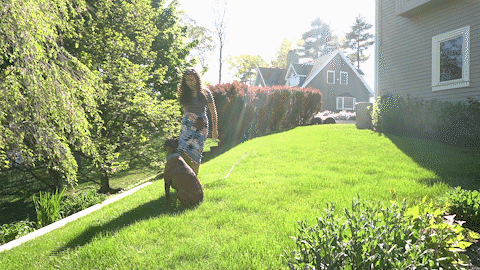How to Add Distance to Your Stay Training
Training your dog to stay in one spot while you move away from them can be so hard! Here are a few tips to guide you through the process of adding distance to your training when you are working on stay or similar behaviors.
Start really small.
Starting by taking just one step away will introduce the idea that your dog shouldn’t always follow as you move. If one step is too hard, try just stepping backwards with one leg, tapping your toe behind you, or even just leaning your weight away with your feet in place.
Start by rewarding your dog for staying in place while you take just one step away.
If needed, you can start with a quick toe tap instead.
Once your dog can handle one step, you can move to two, then three, then four, then five.
Then you can double the distance.
Once your dog can handle 5 steps, which is about 10 feet, you can switch to doubling your distance as your dog is ready to progress. So from 5 steps/10 feet to 20 feet to 40 feet to 80 feet.
Pretend you are on a bungee cord.
Imagine that you are attached to your dog by a bungee cord. As soon as you get out as far as you are planning to go, the cord pulls you right back over to your dog. You don’t pause before returning, which would inadvertently increase duration along with distance.
I stop a few feet in front of Kona to keep her from feeling crowded or overwhelmed.
Give your dog’s treats in position.
Your dog will be more encouraged to stay in their spot if that is where they get their rewards.
Leave a little space for your dog.
You don’t want to crowd your dog or freak them out as you come back over to them, so try to stop about 3 feet away from where they are rather than coming in super close.
Face your dog as you move away.
Facing your dog and walking backwards is generally easier for the initial steps of your training plan. You’ll notice any issues more quickly, and your dog is more likely to stay if you are watching them.
I usually switch to walking normally once I get to 5 steps.
Go slow when going out of sight.
Going out of sight is almost a totally different thing than adding distance. So start by just popping out of sight for a second or less.
Once your dog can handle that, you’ll actually want to approach increasing the time you spend out of sight by focusing on the duration of it rather than how far away you go.
Use a long leash for safety outdoors.
Unless you are in a securely fenced area, a long leash will allow you to keep your dog safe while practicing. You can choose which leash to use and decide whether to hold it or lay it out on the ground based on local leash laws and what will be safest for you and your dog.
You can check out this video to get a little more insight into these tips.
Happy training!






